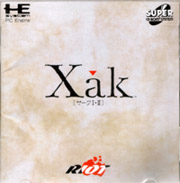Setting and story
Xak features a typical high fantasy setting. According to the game world's legends, a great war was fought between the benevolent but weakening ancient gods and a demon race, which led to the collapse and eventual mortality of the gods. After this 'War of Sealing', the gods divided the world into three parts: Xak, the world of humans, Oceanity, the world of faeries, and Xexis, the world of demons. The demon world of Xexis was tightly sealed from the other two worlds as to prevent reentry of the warmongering demon race. Some demons were left behind in Xak, however, and others managed to discover a separate means to enter Xak from Xexis anyway.
One them, Badu, was a very powerful demon, able to use coercive magic to make humans do his bidding. Duel, the god of war, managed to defeat Badu and seal him away in a mountain of ice for 250 years. The god later settled in a village known as Fearless to live out the rest of his mortal life.
At the beginning of the game, Badu's prison is broken. Demons overrun parts of Xak once again. In order to stop the ravaging of his lands, the King of Wavis sends a messenger faerie to Dork Kart, a famous warrior living in the village of Fearless. Dork, however, has gone missing. The player takes on the role of Latok Kart, Dork's 16-year-old son, as he meets the messenger faerie, Pixie. Latok embarks on the King's quest to slay Badu, hoping to find his father along the way.
In his travels, Latok is guided by Duel's spirit. Over the course of the game, it turns out that Dork and thus Latok is a descendant of Duel.
As this first adventure ends, Latok is able to triumph over the demon Zemu Badu. One of Badu's minions escaped, a black-robed man known only as Necromancer. Three years later, the Necromancer is able to contact one of his allies from the demon world of Xexis: a fearsome demon called Zamu Gospel. Following a prophecy foretold by an ancient and extremely powerful sorcerer by the name of Amadok, the Necromancer and three other demons (referred to as Demonlords) are attempting to complete a dark ritual which will revive Zamu Gospel into the world of Xak.
Xak's setting is centered on Latok's hometown of Fearless and his journeys take him to several other towns, fortresses and villages and eventually into a secret underground world known as the Land of Fire as he makes his way to the royal palace of Wavis.
Xak II's setting is a vast region situated around a single central village of Banuwa to the North of the locations of areas visited in Xak and its neighbouring forests, crystal mines, an ancient castle and a mountainous island ruin.
Gameplay
Xak I & II is a classic dungeon crawl, in that the game proceeds by the player finding his way through labyrinthine maps, defeating opposing monsters on the way. In each map, keys, NPCs and other objects have to be found to gain entrance to the room where a boss dwells. After defeating the boss, the player can proceed towards the next map, where the structure repeats. Various sub-quests involving NPCs are present, most of them obligatory.
Combat is in real-time. The player's character walks around on the game maps, as well as the monster characters. Each character has an attack and defense rating, different for each of its four sides. Moreover, Latok's ratings change depending on whether he has his sword drawn (as the player keeps the space bar depressed) or sheathed. As Latok or a monster takes damage or wards off an attack, the character is pushed backwards. This combat system requires some manual dexterity, especially during boss fights—bosses are generally several times larger than Latok himself.
Latok advances in power through a classic leveling system. Moreover, there are several shops scattered through the game where Latok can buy stronger swords, armors and shields. Gold, the game's currency, and experience points are awarded for killing monsters that wander the map.
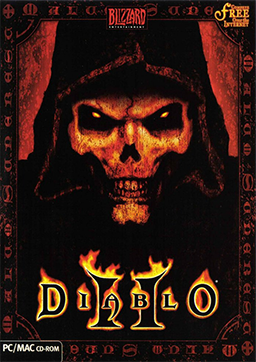
Diablo II is an action role-playing hack-and-slash video game developed by Blizzard North and published by Blizzard Entertainment in 2000 for Microsoft Windows, Classic Mac OS, and OS X. The game, with its dark fantasy and horror themes, was conceptualized and designed by David Brevik and Erich Schaefer, who, with Max Schaefer, acted as project leads on the game. The producers were Matthew Householder and Bill Roper. The game was developed over a three-year period, with a crunch time of a year and a half.
Ryuji Sasai is a Japanese video game composer and bass guitarist. He is best known for his work on Xak, Final Fantasy Legend III and Final Fantasy Mystic Quest. His musical career came about when he was 15 years old, and he formed a band. Before entering the gaming industry, Sasai was involved in the anime department, scoring two television series and a film. After creating music for four games as a freelancer, he was employed at Square from 1991 to 1998, where he worked on five games in total. Sasai often collaborated with fellow composers Tadahiro Nitta and Chihiro Fujioka during his career. He has also been a member of the rock bands Novela and Action and is currently performing as a bassist.
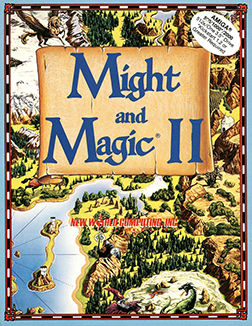
Might and Magic II: Gates to Another World is a role-playing video game developed and published by New World Computing in 1988. It is the sequel to Might and Magic Book One: The Secret of the Inner Sanctum.

Might and Magic VIII: Day of the Destroyer is a role-playing video game developed for Microsoft Windows by New World Computing and released in 2000 by The 3DO Company. It is the eighth game in the Might and Magic series. The game received middling critical reviews, a first for the series, with several critics citing the game's length and its increasingly dated game engine, which had been left fundamentally unaltered since Might and Magic VI: The Mandate of Heaven in 1998. The game was later ported to PlayStation 2 in Japan and published by Imagineer on September 6, 2001.

Final Fantasy IV, a role-playing video game released by Square in 1991, revolves around Cecil Harvey, a knight of Baron who embarks on a quest to defeat Golbez, a man that is controlling the king of Baron. During Cecil's quest, he is joined by his childhood friends Kain Highwind and Rosa Farrell, as well as other warriors from around the world who also seek to stop Golbez. The visuals of the characters were designed by Yoshitaka Amano. After its initial release, Final Fantasy IV was later ported to multiple consoles. In 2007, Square Enix released an enhanced remake for the Nintendo DS that added voice acting to both the Japanese and English versions.
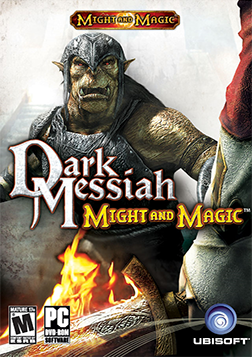
Dark Messiah of Might and Magic is a first-person action role-playing game developed by Arkane Studios. The player controls Sareth, the apprentice of the wizard Phenrig, after he is sent to the city of Stonehelm to accompany an expedition trying to retrieve a powerful artifact known as "The Skull of Shadows".
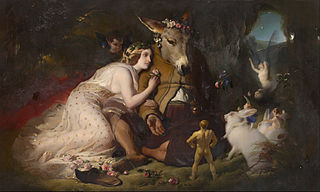
Titania is a character in William Shakespeare's 1595–1596 play A Midsummer Night's Dream.
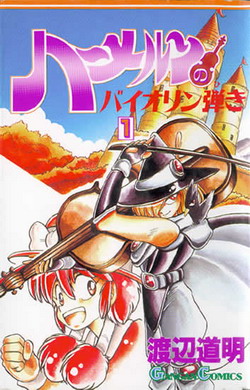
Violinist of Hameln is a Japanese manga series created by Michiaki Watanabe. The manga revolves around a group of adventurers named Hamel, Flute, Raiel, Trom and Sizer. They set off on a perilous journey north to the demon continent, seeking to avert a catastrophic event. Hamel, armed only with his magical violin, uses his music to persuade his monstrous adversaries to atone for their misdeeds and meet their demise by killing themselves.

Magical Circle Guru Guru is a Japanese manga by Hiroyuki Etō, which was serialized in Enix's Monthly Shōnen Gangan from 1992 to 2003. It was later adapted into an anime series on October 13, 1994. A second manga series was serialized in Gangan Online in 2012.
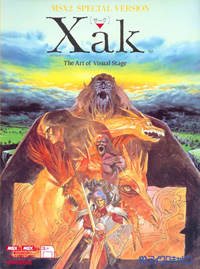
Xak: The Art of Visual Stage (サーク) is the first game in the fantasy role-playing video game series Xak developed and published by Microcabin. It was originally released for the PC-88 computer system, with subsequent versions being developed for the PC-98, X68000, MSX2, PC Engine, Super Famicom, and mobile phones. The first four versions were re-released for Windows on the online store Project EGG. An English translation of Xak: The Art of Visual Stage was also released in 2007 on the now-defunct retro gaming service WOOMB.net, and became available on Project EGG.

Xak II: Rising of the Redmoon is a fantasy role-playing video game developed and published by the Japanese software developer Microcabin. It is a direct sequel to Xak: The Art of Visual Stage. The game was released in Japan only, but due to a MSX scene that arose in Europe some of the MSX versions of Xak received fan translations. An enhanced remake was later released for the PC Engine, together with the first game in the series Xak as Xak I & II by Telenet Japan's development team Riot.
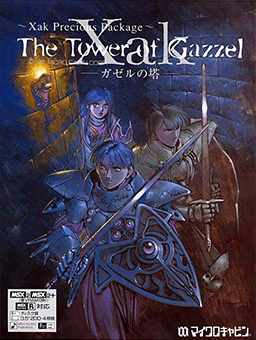
Xak Precious Package: The Tower of Gazzel is a fantasy role-playing video game developed and published by the Japanese software developer Microcabin. The game is a direct sequel to Xak: The Art of Visual Stage and Xak II: The Rising of the Red Moon. While technically being the third installment of the series, The Tower of Gazzel is a sidestory taking place between the events of Xak II and Xak III. The game was released in Japan only.

Three Hearts and Three Lions is a 1961 fantasy novel by American writer Poul Anderson, expanded from a 1953 novella by Anderson which appeared in Fantasy & Science Fiction magazine.

Fray in Magical Adventure, also known as just Fray (フレイ) and Fray-Xak Epilogue (Gaiden), is a 1990 spin-off "gaiden" (sidestory) game in a role-playing video game series Xak developed and published by the Japanese software developer Microcabin. Even though it is directly connected to the more serious Xak storyline, Fray has a less serious tone and light-hearted comedic approach to telling the story. It was originally released for the MSX2 and was later ported to several different systems, among them MSX Turbo R, PC-98, PC Engine, and Game Gear.
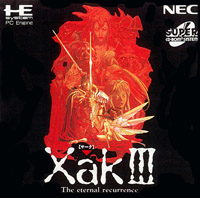
Xak III: The Eternal Recurrence is the final game in a fantasy role-playing video game series called Xak developed and published by the Japanese software developers Microcabin and NEC. Xak III was originally under development to be released for the MSX2 but shortly after Xak: The Tower of Gazzel was released, the development project was halted. After several years the project was continued and finally released simultaneously for the PC-98 and FM Towns. A year later, Xak III was released for the PC Engine CD; this version has since been unofficially translated into English.

Golden Axe is a series of side-scrolling beat 'em up arcade video games developed by Sega. The series takes place in a medieval fantasy world where several heroes have the task of recovering the legendary Golden Axe, the mainstay element of the series.
The Gamers: Dorkness Rising is a feature-length film produced by Dead Gentlemen Productions, and focuses on a group of tabletop role-playing gamers as their gamemaster attempts to shepherd them through a campaign that they have played through three times and have yet to actually finish. While the film is set in the same universe as and has a similar theme to its predecessor, The Gamers, it is not a direct sequel to the first film, as it focuses on a different group of players. Also, unlike its predecessor, this film dedicates a substantial portion of the film to the players themselves, and not their characters. It began filming in 2005 and was set for release in 2006, and was finally released at Gen Con in Indianapolis by Anthem Pictures on August 14, 2008. Paizo had an exclusive sales window for the 2008 Gen Con convention where the cast and crew of The Gamers: Dorkness Rising were signing copies at the Paizo booth.

Diablo is an action role-playing dungeon crawler video game series developed by Blizzard North and continued by Blizzard Entertainment after the North studio shut down in 2005. The series is made up of four core games: Diablo, Diablo II, Diablo III, and Diablo IV. Expansions include the third-party published Hellfire, which follows the first game; Lord of Destruction, published by Blizzard and released after the second game; and Reaper of Souls, which follows the third game. Additional content is provided through story elements explored in other types of media forms.

Mythica is a series of primarily direct-to-video fantasy films. The films are produced by Arrowstorm Entertainment, with first film Mythica: A Quest for Heroes being partly funded by a Kickstarter campaign that collected $94,294. There are six films in the Mythica series, all produced and co-written by Jason Faller and Kynan Griffin. The films star Melanie Stone as Marek, an escaped slave girl and budding magician, and co-star Kevin Sorbo as Gojun Pye the magician who trains her, along with Adam Johnson, Jake Stormoen, and Nicola Posener as those that team up with Marek on various quests together.
